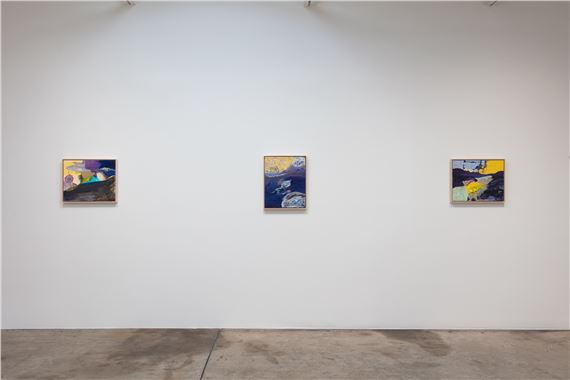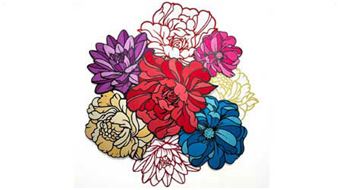Eva Lundsager: Time is Very Quick
Often beginning with a single horizontal line, Lundsager鈥檚 paintings are developed intuitively, though it鈥檚 an intuition built on decades of looking, living, and painting. The artist鈥檚 first mark determines the next. Accumulations occur, get erased, then reformed as her compositions bloom through her acute attention to and relationship with the material. Large swaths of color buttress against areas of delicate line work, melting into organic forms, evoking rolling hills, still waters and atmosphere, or even plant life. The combination of transcendental images with Lundsager鈥檚 expressive mark-making speaks to the complexity of the human experience. In the painting If it (2024), broad and bright brush strokes sweep across the top of the canvas, revealing slivers of another world just beyond the drips. Below the heat of the orange and yellow sweeps of color are two speckled masses that seem to have split apart, one floating in the atmosphere above its counterpart, reminiscent of a parent and child, evolving organisms, or even body and spirit. Eva Lundsager鈥檚 paintings are full of possibilities. The artist鈥檚 use of movement, form and rhythm in If it (2024) creates space on the painted surface and within the viewer to reflect, contemplate and dream.
While Lundsager鈥檚 layered compositions often feel otherworldly, the presence of the artist鈥檚 hand in the work, developed through thirty-five years of painting, is unmistakable and deeply personal. Through rich color, energetic line, and impassioned form, the artist honors the complexity of life in all its forms. In the series Here we witness (2024), a single blue line is stretched across four canvases. Evolving between each image and leaving traces of itself behind along the way, the blue line becomes more complicated as it makes its journey. Spans of red and orange hover above the blue line throughout the series, until finally the two become one in the final canvas. The mesmerizing blue line, much like a horizon line, denotes the distinction between two beings or worlds, and its surrender to the red expanse above relates to the transformations and changes that we might experience in our own lives. The continuous line in Here we witness gently carries the viewer through time and space, speaking to the exhibition鈥檚 title Time is Very Quick, which is an adage Lundsager鈥檚 mother-in-law would often say.

Recommended for you
Often beginning with a single horizontal line, Lundsager鈥檚 paintings are developed intuitively, though it鈥檚 an intuition built on decades of looking, living, and painting. The artist鈥檚 first mark determines the next. Accumulations occur, get erased, then reformed as her compositions bloom through her acute attention to and relationship with the material. Large swaths of color buttress against areas of delicate line work, melting into organic forms, evoking rolling hills, still waters and atmosphere, or even plant life. The combination of transcendental images with Lundsager鈥檚 expressive mark-making speaks to the complexity of the human experience. In the painting If it (2024), broad and bright brush strokes sweep across the top of the canvas, revealing slivers of another world just beyond the drips. Below the heat of the orange and yellow sweeps of color are two speckled masses that seem to have split apart, one floating in the atmosphere above its counterpart, reminiscent of a parent and child, evolving organisms, or even body and spirit. Eva Lundsager鈥檚 paintings are full of possibilities. The artist鈥檚 use of movement, form and rhythm in If it (2024) creates space on the painted surface and within the viewer to reflect, contemplate and dream.
While Lundsager鈥檚 layered compositions often feel otherworldly, the presence of the artist鈥檚 hand in the work, developed through thirty-five years of painting, is unmistakable and deeply personal. Through rich color, energetic line, and impassioned form, the artist honors the complexity of life in all its forms. In the series Here we witness (2024), a single blue line is stretched across four canvases. Evolving between each image and leaving traces of itself behind along the way, the blue line becomes more complicated as it makes its journey. Spans of red and orange hover above the blue line throughout the series, until finally the two become one in the final canvas. The mesmerizing blue line, much like a horizon line, denotes the distinction between two beings or worlds, and its surrender to the red expanse above relates to the transformations and changes that we might experience in our own lives. The continuous line in Here we witness gently carries the viewer through time and space, speaking to the exhibition鈥檚 title Time is Very Quick, which is an adage Lundsager鈥檚 mother-in-law would often say.
Artists on show
Contact details

Related articles
For three and a half decades, Eva Lundsager has essayed nature-oriented abstraction in a variety of two-dimensional mediums.

 ARTISTS
ARTISTS








